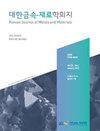添加Cu和Zr对A356合金热处理相变及力学性能的影响
IF 1.4
4区 材料科学
Q4 MATERIALS SCIENCE, MULTIDISCIPLINARY
引用次数: 0
摘要
铸造A356(Al-Si-Mg)合金具有良好的机械性能和铸造性能,广泛应用于汽车和一般应用。Al-Si-Mg-(Cu)合金通常在170℃以上由于析出物变粗而失去强度,这限制了它们在部件上的应用。为了在高温下保持其强度,Al-Si-Mg-(Cu)合金通过添加过渡金属进行改性。由于Zr可以形成像Al3Zr这样的热稳定相,因此研究了添加Zr对铸铝硅合金高温力学性能的影响。尽管已有Cu和Zr对铸态Al-Si-Mg-(Cu)合金力学性能影响的相关研究,但Zr对热处理过程中相变和力学性能影响的研究仍然有限。研究了Cu和Zr对A356铸造合金热处理过程中相变和力学性能的影响。在Al3Zr晶体结构中,Si和Ti取代Al和Zr,形成针状和块状(Al,Si)3(Ti,Zr)弥散体。随着固溶时间的延长,Zr分散体的尺寸减小,同时析出更小的Zr颗粒,导致Zr分散体的面积分数降低。此外,固溶热处理过程中,Cu的加入加速了Al-Si-Mg-Cu-Zr合金中Zr分散体的亚稳L12组织转变为稳定的D023组织。通过拉伸和低周疲劳(LCF)试验揭示了(Al,Si)3(Ti,Zr)分散体对力学性能的影响。结果表明,随着固溶热处理时间的延长,在保持强度的同时,高温下伸长率得到了大幅度提高,从而改善了低周疲劳性能。本文章由计算机程序翻译,如有差异,请以英文原文为准。
Investigation of Phase Transformation and Mechanical Properties of A356 Alloy with Cu and Zr Addition during Heat Treatment
Cast A356(Al-Si-Mg) alloys are widely used in automotive and general applications because of their mechanical properties and castability. Al-Si-Mg-(Cu) alloys typically lose their strength above 170 o C due to coarsening of precipitates, which limits their application to components. To maintain their strength at elevated temperature, Al-Si-Mg-(Cu) alloys are modified by adding transitional metals. Several studies have been carried out to evaluate the effect of Zr addition on the high temperature mechanical properties of cast Al-Si alloys because Zr can form thermally stable phases such as Al3Zr. Despite the relative studies on the influence of Cu and Zr on the mechanical properties of cast Al-Si-Mg-(Cu) alloys, investigations of the effect of Zr on the phase transformations and the mechanical properties during heat treatment remains limited. In this study, the effects of added Cu and Zr on the phase transformations and the mechanical performance during heat treatment of A356 cast alloy were investigated. Needle-like and block-like (Al,Si)3(Ti,Zr) dispersoids formed as some Si and Ti replaced Al and Zr in Al3Zr crystal structures were generally observed. Furthermore, with increasing solution treatment time, the size of Zr dispersoids was reduced, and smaller Zr particles were precipitated at the same time, which caused a decrease in the area fraction of the Zr dispersoids. In addition, the metastable L12 structures of Zr dispersoids in Al-Si-Mg-Cu-Zr alloys were transformed into stable D023 during solution heat treatment as the Cu addition accelerated the transformation. Tensile and low-cycle fatigue (LCF) tests were performed to reveal the effects of (Al,Si)3(Ti,Zr) dispersoids on mechanical properties. As a result, elongation at elevated temperature was highly increased, while maintaining strength, according to the increase in solution heat treatment time, which improved low-cycle fatigue properties.
求助全文
通过发布文献求助,成功后即可免费获取论文全文。
去求助
来源期刊

Korean Journal of Metals and Materials
MATERIALS SCIENCE, MULTIDISCIPLINARY-METALLURGY & METALLURGICAL ENGINEERING
CiteScore
1.80
自引率
58.30%
发文量
100
审稿时长
4-8 weeks
期刊介绍:
The Korean Journal of Metals and Materials is a representative Korean-language journal of the Korean Institute of Metals and Materials (KIM); it publishes domestic and foreign academic papers related to metals and materials, in abroad range of fields from metals and materials to nano-materials, biomaterials, functional materials, energy materials, and new materials, and its official ISO designation is Korean J. Met. Mater.
 求助内容:
求助内容: 应助结果提醒方式:
应助结果提醒方式:


